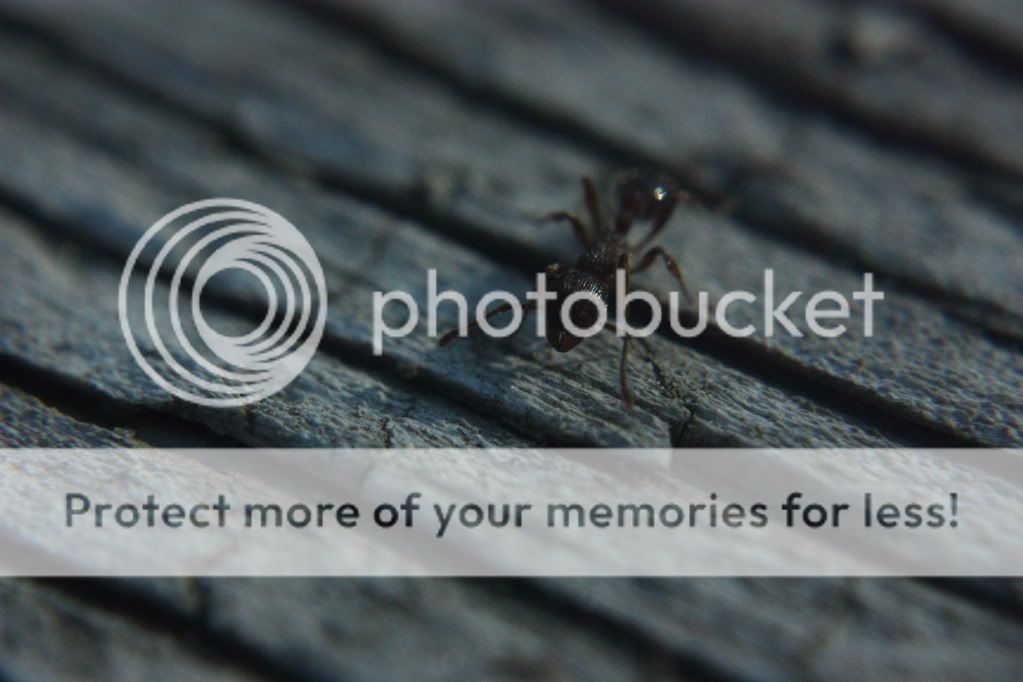antcatcher
TPF Noob!
- Joined
- Dec 27, 2010
- Messages
- 5
- Reaction score
- 0
- Location
- Massachusetts
- Can others edit my Photos
- Photos OK to edit
Hi guys, I am new here and am a hobbyist that loves macro photography, mostly of Hymenoptera. Right now I am considering getting some accessories to make macro photographs easier or better. I want to but these four items and want to know your opinion of some of the photographers on this board. My budget is about 150, but I can go a little over or under and not including shipping costs. My camera body is a canon rebel xsi.
Amazon.com: Macro Ring Flash LED Light! Works with Canon/Sony/Nikon/Sigma lenses!: Camera & Photo
Its the only flash I can find that I can afford, and I was hoping it would help in situations like this. The ant should have been red and the IOS is already set at max and shudder speed of 200.

Amazon.com: Fotodiox 7 Metal Step Up Ring Set, Anodized Black Metal 49-52mm, 52-55mm, 55-58mm, 58-62mm, 62-67mm, 67-72mm, 72-77mm: Camera & Photo
I want these to attach my 70-300mm to my 28-50mm or vice-versa, but I am not sure if I would get the magnification either way or if the set is worth it with only owning 2 lenses.
Amazon.com: Fotodiox 58mm Filter Thread Lens, Macro Reverse Ring Camera Mount Adapter for Canon EOS 1d,1ds,Mark II, III, IV, 5D, Mark II, 7D, 10D, 20D, 30D, 40D, 50D, 60D, Digital Rebel xt, xti, xs, xsi, t1i, t2i, 300D, 350D, 400D, 450D, 500D, 550D,
This I want to reverse only my 28-50mm lens (filter size is a 58) and I want to make sure its a good buy.
Amazon.com: Opteka Auto Focus DG Macro Extension Tube Set for Canon EOS Digital SLR Cameras: 47th Street Photo Finally I want to get these extension tubes for both my lenses to give some more options.
Also I would be interested to find out about some other good low cost lenses I might want to get later. Thanks for any help!
Amazon.com: Macro Ring Flash LED Light! Works with Canon/Sony/Nikon/Sigma lenses!: Camera & Photo
Its the only flash I can find that I can afford, and I was hoping it would help in situations like this. The ant should have been red and the IOS is already set at max and shudder speed of 200.

Amazon.com: Fotodiox 7 Metal Step Up Ring Set, Anodized Black Metal 49-52mm, 52-55mm, 55-58mm, 58-62mm, 62-67mm, 67-72mm, 72-77mm: Camera & Photo
I want these to attach my 70-300mm to my 28-50mm or vice-versa, but I am not sure if I would get the magnification either way or if the set is worth it with only owning 2 lenses.
Amazon.com: Fotodiox 58mm Filter Thread Lens, Macro Reverse Ring Camera Mount Adapter for Canon EOS 1d,1ds,Mark II, III, IV, 5D, Mark II, 7D, 10D, 20D, 30D, 40D, 50D, 60D, Digital Rebel xt, xti, xs, xsi, t1i, t2i, 300D, 350D, 400D, 450D, 500D, 550D,
This I want to reverse only my 28-50mm lens (filter size is a 58) and I want to make sure its a good buy.
Amazon.com: Opteka Auto Focus DG Macro Extension Tube Set for Canon EOS Digital SLR Cameras: 47th Street Photo Finally I want to get these extension tubes for both my lenses to give some more options.
Also I would be interested to find out about some other good low cost lenses I might want to get later. Thanks for any help!








![[No title]](/data/xfmg/thumbnail/32/32179-99b00fe3df8a5ed7303ced76980128fd.jpg?1734161047)



